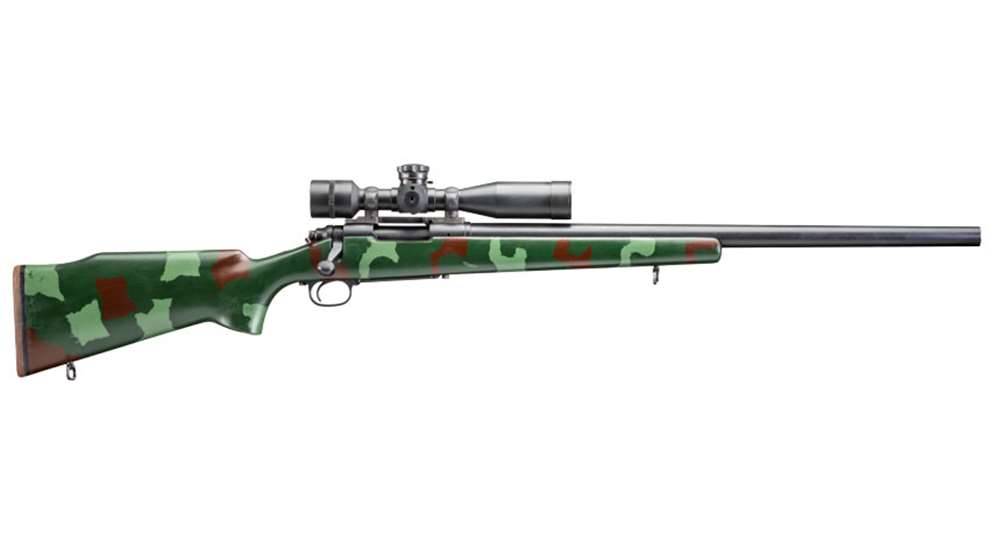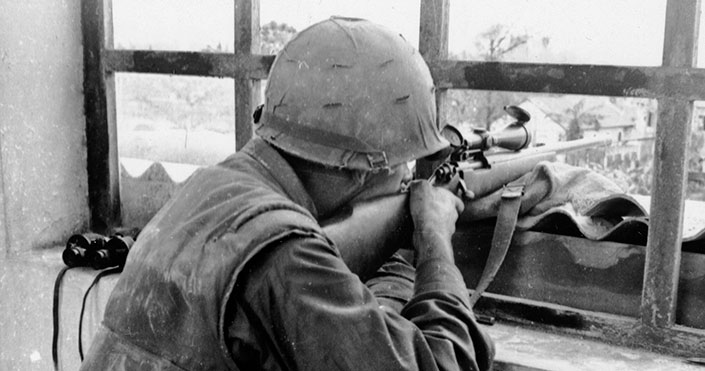
The tradition of American military sniping stretches back to the Civil War when specialized equipment was first developed to get the job done. For example, the .451-caliber Whitworth rifle, with its 1:20-inch-twist hexagonal rifling and its side-mounted telescopic sight, made Confederate snipers a meaningful battlefield threat. World War I brought the Model of 1903 rifle equipped with the Warner & Swasey scope, and World War II brought the M1903A1 and the M1903A4. Thereafter, the mighty Garand rifle armed U.S. Army and USMC snipers in the form of the M1C and the M1D rifles.
Although the M1D remained in inventory as the war in Vietnam began to spool up, it was nearing the end of its service life, and it chambered a cartridge that was in the process of being phased out. For those reasons, the Marine Corps began looking for a more-contemporary sniper rifle and it found what it was looking for in Herkimer County, NY.
Prior to 1966, Marines in Vietnam used the Winchester Model 70 rifle in .30-’06 Sprg.—and even the .50-caliber Browning machine gun—in the sniping role, but those weapons did not provide the ideal platform. When Remington Arms, on the Mohawk River in the village of Ilion, near Utica, indicated a willingness to work with the USMC toward the creation of a custom rifle, a partnership was born that would last decades. What the company submitted was a modified version of its Model 700/40X target rifle that was chambered for the short-action 7.62 NATO cartridge.

The gun featured a freefloat, 24-inch, medium-weight barrel with a 1:10-inch twist and factory bedding, a one-piece wood stock with no checkering and two fixed sling swivels. It was built on the short-action Model 700 using a cock-on-open bolt feeding from an internal-box magazine with five-round capacity. Remington delivered the rifles with a matte Parkerized finish and a commercial Redfield 3-9X Accu-Range variable-power scope presenting a distinctive green anodized finish. The scope mounted to the receiver through the use of a Redfield base and 1-inch short rings.
The Marine Corps officially adopted the rifle on April 7, 1966 as the M40 and promptly ordered 700 units. Those examples wrote themselves into USMC history during fighting in places like Huế in early 1968 when one especially dramatic photograph captured a Marine sniper armed with an M40 preparing to send a shot through a third-floor window in the city during the battle. The M40 was put to severe use during the Vietnam years, with predictable results: by 1973, only 425 of the original 700 M40s issued remained in serviceable condition.

Because of this situation, in the years immediately following the end of the American experience in Vietnam, the Marine Corps recognized that it was time to upgrade the most-critical component of its Scout Sniper program. Toward that end, a modified version of the M40 was developed that built on lessons learned during years of war in Southeast Asia.
To begin with, the M40’s stock was eliminated because it was found that wood tended to warp in the high-humidity environment of the jungle. A synthetic stock made by McMillan and finished in green and earthtone red camouflage replaced it. In addition to that, a 24-inch Atkinson barrel with 1:12-inch-twist rifling optimized for the M118 Match cartridge replaced the M40’s Remington-made barrel.
The combination of the new barrel and the replacement of certain aluminum components with steel components made the new rifle heavier than its predecessor—3 pounds heavier. The improved rifle was adopted in 1977 with the designation M40A1 and it was paired with a Unertl 10X scope specifically made for it.
The A1 version of the M40 would serve the Marine Corps for more than 20 years, during which time the international balance of power shifted and shook. The Soviets invaded Afghanistan, the Islamic Revolution swept across Iran, the Berlin Wall came down and genocide ravaged Rwanda. Through it all, U.S. Marines were sent on overseas missions to places like Lebanon, Iraq and Somalia.
One of the young Marines who carried an M40A1 during those troubled times was LCpl Anthony Swofford, a Scout Sniper with the Surveillance and Target Acquisition Platoon of the 2nd Battalion, 7th Marine Regiment. He went on to chronicle his experiences during Operations Desert Shield and Desert Storm in the 2003 book “Jarhead.” Anyone familiar with the book will know Swofford became proficient with the M40A1, only to never fire a single shot through it in action.




































